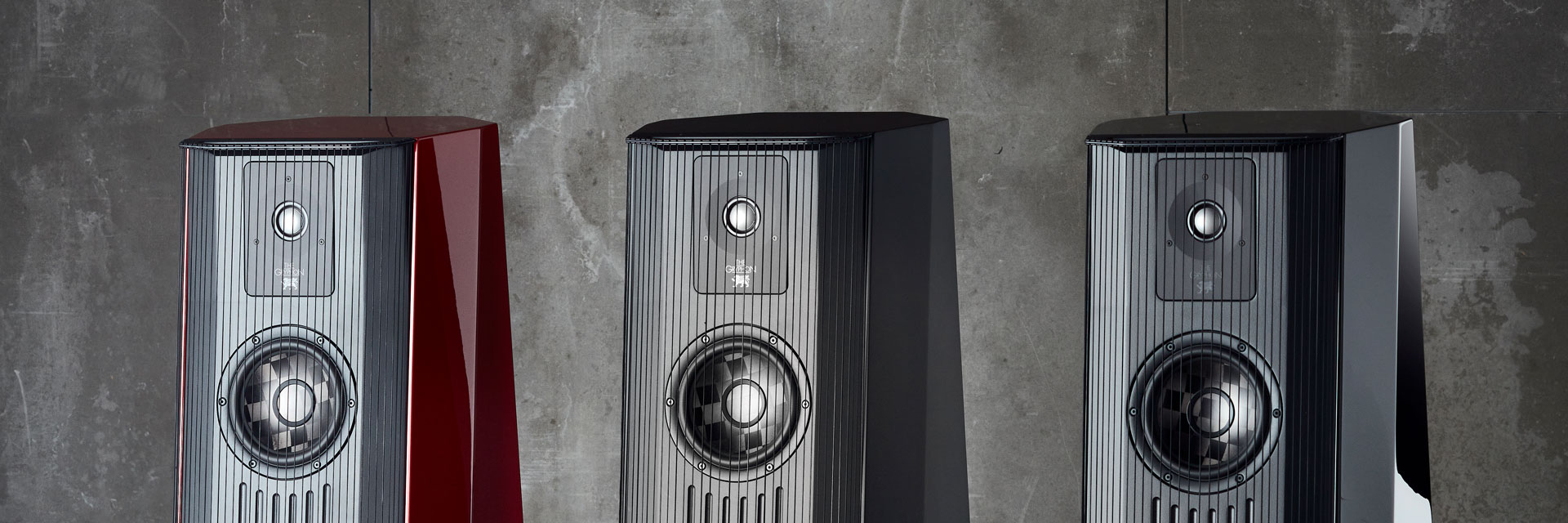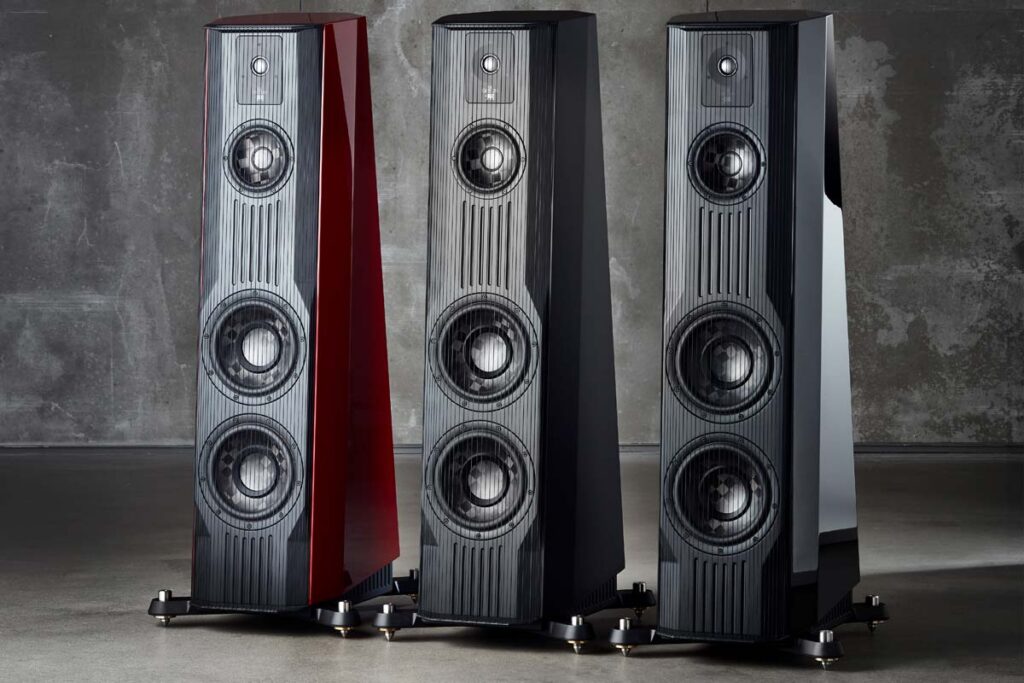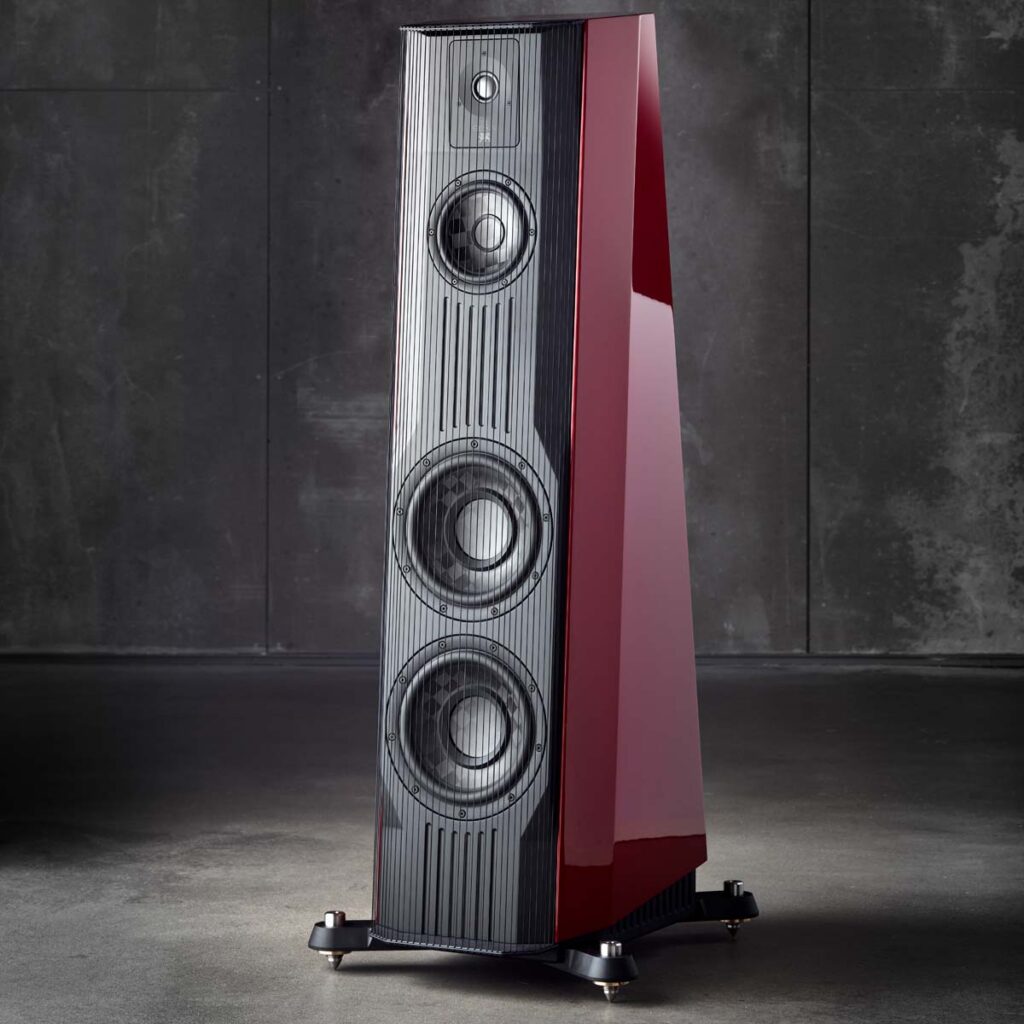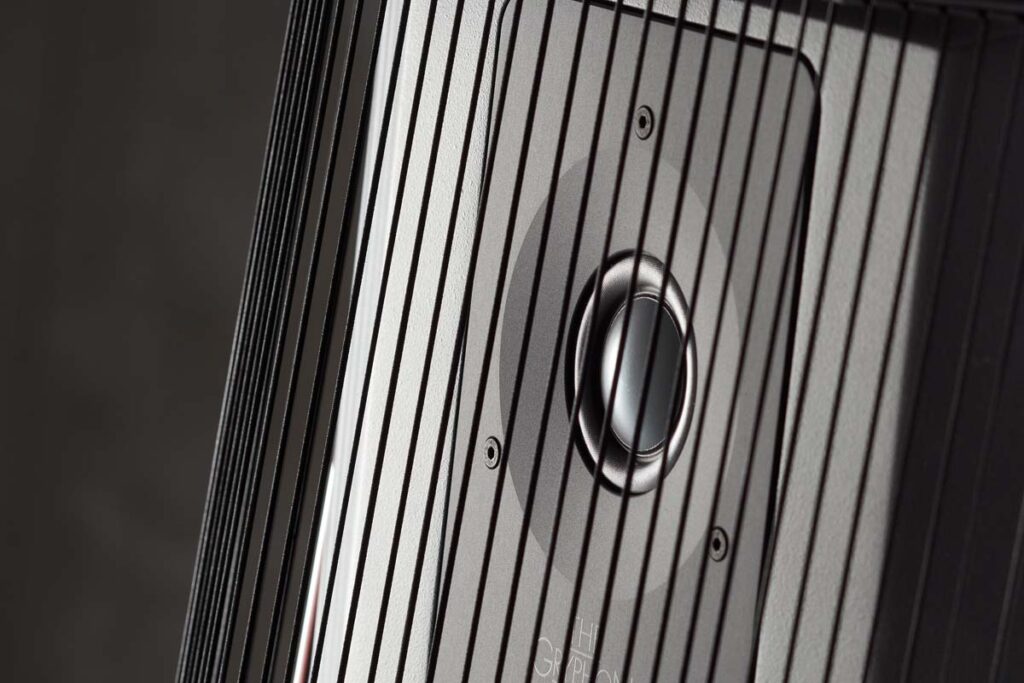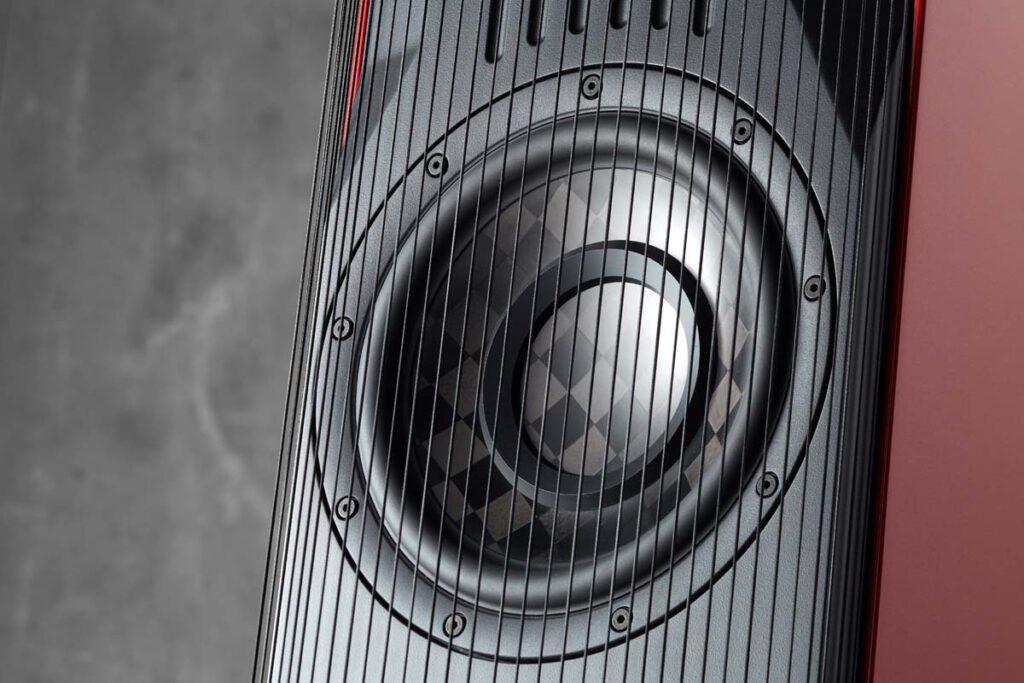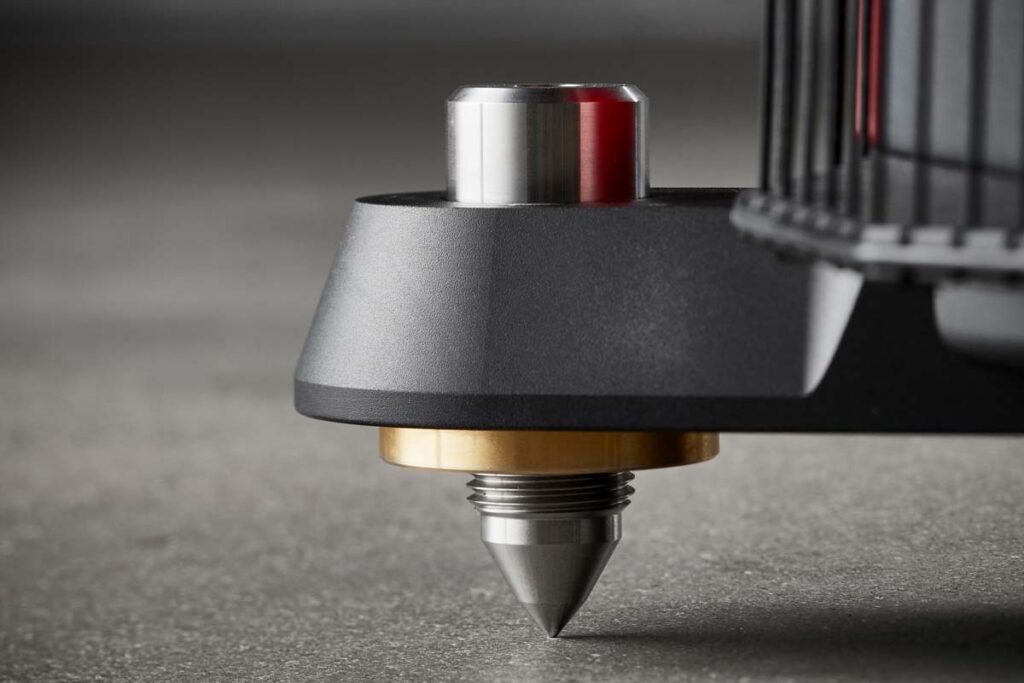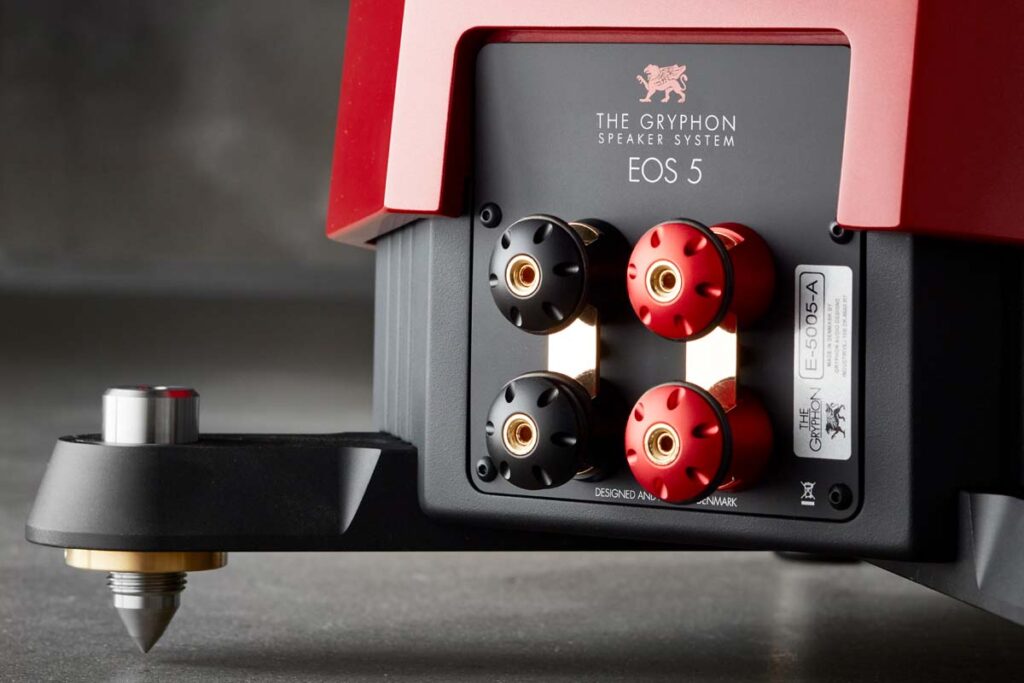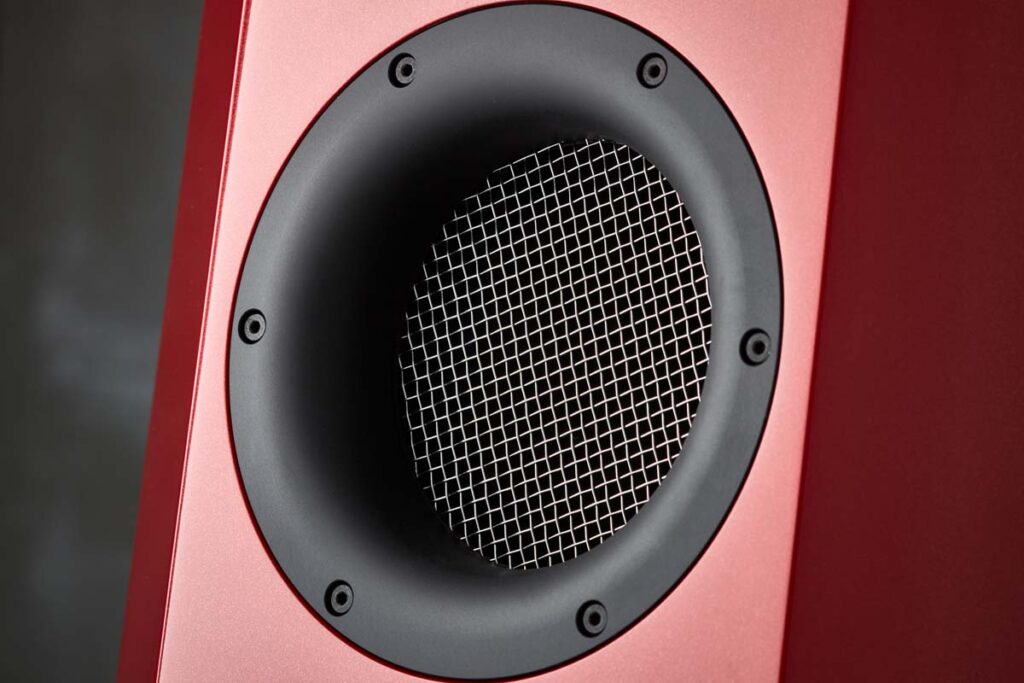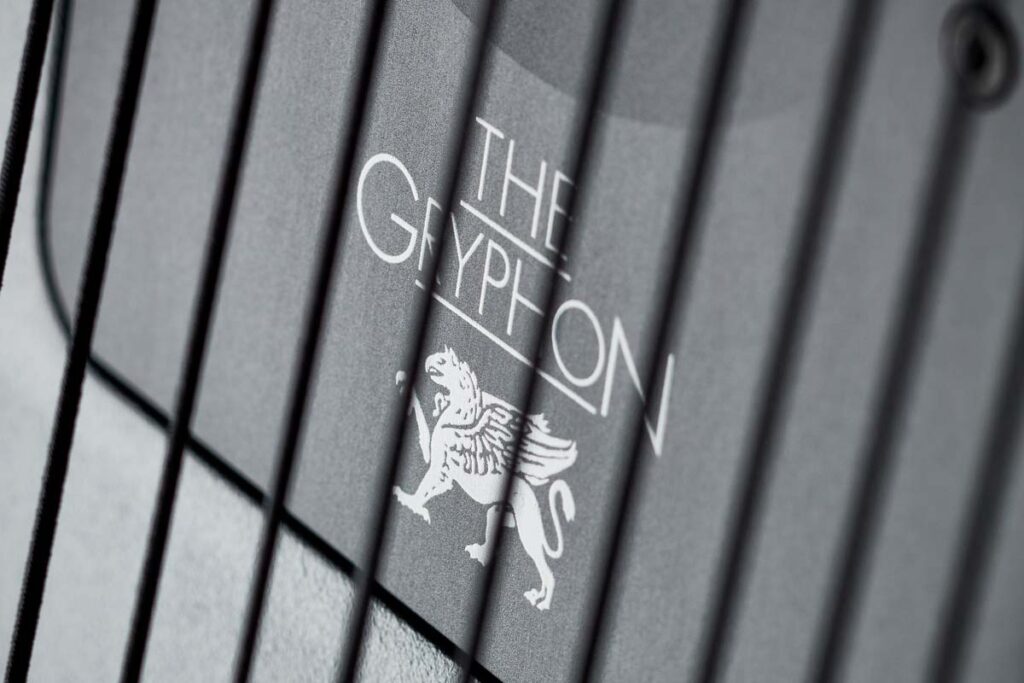Three-way crossover, ported enclosure, dynamic drivers – of course more exotic technological approaches would make it easier to be the talk in town. But Gryphon has moved past having to prove anything ages ago – the Eos 5 turns heads even so, leveraging state-of-the-art materials and four decades of development experience to demonstrate how supposedly fully developed approaches can still be taken to a new level.
Some things are well worth the wait: Two years ago at the HIGH END in Munich, we noticed the lovely little Eos 2 at the Danish company’s stand – in typical Gryphon style with an extremely striking design and in a bold, high-gloss red. As much as we were looking forward to the small floorstanding speaker, we had to be realistic: In the meantime, as you know, we have changed our location within Munich, which meant that our listening room now measures an cavernous 55 square meters instead of the previous 40 square meters – placing a two-way loudspeaker with a 17-cm bass-midrange driver in a room this size would be bullying and not a review. We therefore remained patient until the loudspeaker manufacturer had placed the much larger Eos 5 on the spikes and immediately requested a pair. After Björn Brormann from the German sales department had arrived with two holy arc sized flight cases which he unloaded in our listening room, our slight panic before unpacking soon gave way to pleased astonishment – some manufacturers do think about manageability when designing their packaging, but few manage this as elegantly as Gryphon: the wooden boxes can be easily dismantled by loosening a few clips by hand to reveal the speaker, which can then be pushed into the listening room via a foam ramp. The aforementioned spikes are only half the story: in their absence, the Eos 5 stands on Teflon glides, which make it remarkably easy to maneuver the 64-kilo lump around on our listening room carpet. This is an advantage that should not be underestimated, as it allows you to experiment with the exact positioning for much longer before your nerves and ATP reserves decide to call it a day, regardless of the actual result. Once the optimal position has been found, the Gryphon Eos 5 can then be clawed into the carpet using the spikes, which are worth a small mention in themselves: they have a removable damping element, so the user can choose between a rigid and (relatively speaking) soft coupling depending on the floor type and sound philosophy.
Compact by brand standards
The first thing I did after initial set-up and a function check is pick up the marketing material for the Eos 5 and had to chuckle while browse through it: as surprisingly easy as the set-up procedure is, we’re still talking about speakers that fill a panel van pretty much to the roof in their cases and, with two 24-cm bass units each, also have a diaphragm area befitting their status. Gryphon, however, speaks of a compact speaker that can reproduce the entire audible frequency spectrum despite its space-saving dimensions. Evidently, the Danes think in different orders of magnitude than most of us – looking at an Apex power amplifier, the in-house classification fits the picture.
Compact or not, the Eos 5 is definitely a true Gryphon: the design alone, with its octagonal footprint and numerous hard angled surfaces that are remotely reminiscent of the facets of a precious stone, radiates exactly the mixture of extravagance and grandeur that we know from the Danish luxury manufacturer. In complete contrast to this – and also to the Eos 2 that we’ve seen at the trade fair demonstrations – the paintwork of our review sample appears downright timid. One of the first things we notice when unpacking is the soft, rubbery feel of the matt black cabinet surfaces. Brormann doesn’t fail to notice our astonishment, and he explains to us straight away that Gryphon has also considered practical issues here and has therefore developed a self-healing matt lacquer. Minor blemishes can be “ironed out” to a certain extent by applying moderate heat, he tells us. Curiosity was great, but greater was the awe – we refrained from putting it to the test.
Classic to Perfection
At first glance, the Gryphon Eos 5 appears fairly conventional in technical terms: a three-way bass reflex speaker with a dome tweeter and cones in the mids and bass – perfectly acceptable; since many roads lead to Rome in hi-fi, why not just take the straight one? However, the technical implementation reveals a considerable degree of technical finesse: Gryphon has treated the tweeter to a beryllium diaphragm, for example, while the midrange and bass drivers rely on the same chessboard-like woven carbon fiber material that some other manufacturers such as Perlisten, Børresen or the supplier SB Acoustics also utilize to great success. What is striking about the Eos 5, however, are the plastic rings applied to the parabolic cone, which are intended to improve the coupling of the cone to the voice coil and thus ensure better impulse response.
Gryphon has generally attached great importance to time alignment during development, even if the manufacturer keeps its cards somewhat close to the chest regarding the technical details. For example, the data sheet mentions a phase-linear three-way loudspeaker, although I was unable to find out exactly what this means in relation to a passive crossover. In any case, the crossover itself is quite elaborately designed: Second-order filters are used in the transition from the mid-range to the high-frequency range, and fourth-order filters are used between the mid-range and woofers, whereby the filter slopes are not linear but increase progressively in their steepness. This elliptical characteristic has two advantages: On the one hand, the filter slopes are gentle at the crossover points, thus facilitating a homogeneous transition between the drivers; on the other hand, the drivers are taken out of the signal path more sharply further into the stopband and thus do not have to transmit the wide bandwidth that is otherwise associated with shallow slopes. Of course, we could nerd out about the technical details all day long, but ultimately it’s the result that counts …
Boxer with velvet gloves
… which is why we now turn to listening instead – and right away, we experience our first little surprise: The developers have obviously done a really good job with the time alignment. Given that the tweeter is positioned quite far away from the midrange driver, I was a little skeptical at first, but the imaging is actually razor-sharp: on one of our numerous test tone CDs posing as music albums, there is a track in which the phase has obviously been played with, resulting in a sound effect moving from the back left to the front and then to the center. The Gryphon Eos 5 communicates its position to me with such pinpoint focus that I feel like I could touch the sound – not a bad first impression at all!
What catches my ear more than anything else, however, is the incredibly smooth presentation that the Danes throw into the room: All too often, outstanding resolution goes hand in hand with a character that can be fatiguing in the long run – especially when a metal dome tweeter is at work in the treble. However, the beryllium tweeter makes me quickly discard any reservations I might have had about rigid tweeter domes. Gryphon specifies an upper cut-off frequency of 40 kilohertz – I can only assume that the dome tweeter breaks up so far above the audible spectrum that the ear doesn’t even get a hint of any ringing. Fine detail resolution and transparency are outstanding even by high-end standards, and even if the two 24 bass drivers can, if required, also get to work in a properly black and growly manner, the overall character never becomes even the slightest bit sharp, let alone grating and always retains this velvety surface texture. This is beautifully illustrated by “Ups and Downs” from the Shuteen Erdenebaatar Quartet’s debut album Rising Sun. In this piece, the young jazz formation around the Munich-based Mongolian pianist throws energetic jazz into the room, which has been captured on the sound medium in excellent production quality. Valentin Renner really lets it rip on the drums here; the Eos 5 lets the full rhythmic energy burst into the room without the presentation becoming unpleasantly oppressive for even a moment. Even in the densest passages, the tweeter reveals details that would simply be lost in the commotion on other setups, and once again presents them with that silky transparency that never gets on your nerves, even with after extended energetic listening sessions. A boxer with velvet gloves – at least in combination with an Accuphase P-7500.
I swap the power plant for a Burmester 216 to get a different perspective and am once again amazed at the clarity with which the Eos 5 can channel the differences in amplifier character. “Gloves off” is now the order of the day: where the Accuphase, with all its obsession with detail, brought the overall musical events together more smoothly and thus probably came closer to the recording, the Burmester thrashed the snare attacks at me with more punch and quite a bit of bite, probably capturing the intention behind the recording a little better.
The Accuphase doesn’t take this lying down and takes the point back with Rimsky-Korsakov’s Sheherazade. Again, to no one’s surprise, both perform at an extremely high level, but with significant differences in musical priorities. The Burmester unleashes the explosiveness of the timpani and brass with unbridled power and impressive control, while the Accuphase fans out a wider stage and also draws a stronger contrast between the melodically flowing and the brash, jagged passages, thus doing the character of the piece a little more justice.
Of course, I cannot and will not choose a winner because of the fundamentally different characters – ultimately the room, music collection and listening taste will dictate the choice of amplifier. But that brings us back to the actual review candidate. We can rightfully expect a transducer of this caliber to be permeable to both music and electronics, but the extent to which these differences become clear via the Gryphon Eos 5 is rare even in this league. The Eos 5 is by no means characterless. With its combination of razor-sharp precision and velvety performance perfectly suitable for extended listening sessions, the tweeter is clearly the star of the show, yet it never pushes itself to the fore of the music, but always puts it in the best light with its brilliance.
Accompanying Equipment
CD players: Accuphase DP-570, Audio Note CD 3.1x, Esoteric K-05XD | Network players/streamers: Lumin P1, Aavik SD-880, T+A PSD 3100 HV | D/A converter: Benchmark DAC3 B | Preamplifiers: Accuphase C-2300, Electrocompaniet EC 4. 8 Mk II | Power amplifiers: Accuphase P-7500, Burmester 216, Electrocompaniet AW-800 | Loudspeakers: Nubert nuZeo 15, Manger c1, Wilson Audio Sasha DAW | Cables: WestminsterLab, AudioQuest, Atlas Cables | Racks: Finite Elemente, Creaktiv, Bassocontinuo
Floorstanding Loudspeaker Gryphon Eos 5
Concept: passive 3-way floorstanding speaker with rear-firing bass reflex channel | Configuration: 1 x 29 mm beryllium tweeter, 1 x 165 mm TPCD midrange driver, 2 x 240 mm woofers | Crossover frequencies: 500 Hz, 2500 Hz | Sensitivity (2.83 V/1 m): 90 dB | Nominal impedance: 4 Ω (2.9 Ω minimum at 80 Hz) | Frequency response (-2 dB): 20 Hz to 40 kHz | Special features: crossover optimized for phase linearity with elliptical filters, self-healing matt lacquer finish (heat treatment required), Teflon glides to facilitate installation | Finishes: Soul Red Crystal, High Gloss Black, S-Mat Black (self-healing) | Dimensions (W/H/D): 49/131/57 cm (incl. stand) | Weight: 64 kg | Warranty period: 5 years | Pair price: around € 58,300
Auditorium
Feidikstraße 93
59065 Hamm
Phone +49 2381 9339-42
info@gryphon-audio.de

